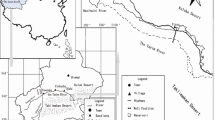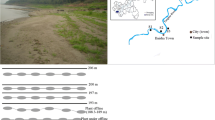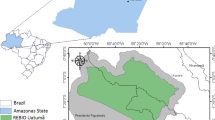Abstract
Dieback of riparian species on floodplains has been attributed to increased soil salinisation due to raised groundwater levels, resulting from irrigation and river regulation. This is exacerbated by a reduction in flooding frequency and duration of inundation. For the Chowilla floodplain on the River Murray raised water tables have increased the amount of salts mobilised in the soil profile, causing the trees to experience salt induced water stress. For the trees to survive in the long term, salts need to be leached from the root zone.
This study investigated whether floodwater infiltrates through channels created by E. largiflorens (black box) roots, flushing salts away from roots, thereby allowing the trees to increase their water uptake. Trees at different sites on the floodplain were artificially flooded, by pumping 1.5 kL of creek water into impoundments constructed around the trees. Gas exchange parameters, and pre-dawn and midday water potential were measured the day before, the day after and one week after the artificial flood and compared against trees that were not flooded. Pre-dawn and midday water potentials were also measured one month after the flood. After flooding, the trees experienced less water stress, indicated by an increase in water potential of less than 0.2 MPa, in comparison to non-flooded control trees. However, this response was not evident one month after flooding. The response to flooding did not result in increased rates of transpiration, stomatal conductance or photosynthesis, even though flooding effectively doubled the trees yearly water supply.
The infiltration of floodwater in the impoundments around E. largiflorens was also compared to that of impoundments on bare ground. Floodwater infiltrated 2 – 17 times faster around trees than on adjacent bare ground, for parts of the floodplain not grazed by livestock. Tracer dye experiments indicated that bulk flow of water through pores down the profile was the reason for the enhanced infiltration. Flooding leached salts in direct vicinity of tree roots, but only leached small amounts of salts from the bulk soil.
Similar content being viewed by others
References
Akeroyd M D, Tyerman S D, Walker G R and Jolly I D 1998 Impact of flooding on the water use of semi-arid riparian eucalypts. J. Hydrol. 206, 104–117.
Blake T J 1981 Salt tolerance of eucalypt species grown in saline solution culture. Aust. For. Res. 11, 179–183.
Boucher J-F, Munson A D and Bernier P Y 1995 Foliar absorption of dew influences shoot water potential and root growth in Pinus strobus seedlings. Tree Physiol. 15, 819–823.
Bureau of Meteorology 2000 Climate averages for Renmark Post Office. URL: http://www.bom.gov.au/climate/averages /tables/cw o24016.shtml.
Burgess S S O, Adams M A, Turner N C and Ong C K 1998 The redistribution of soil water by tree root systems. Oecologia 115,306–311.
Edwards WM, Norton L D and Redmond C E 1988a Characterising macropores that affect infiltration into nontilled soil. Soil Sci. Soc. Am. J. 52, 483–487.
Edwards W M, Shipitalo M J and Norton L D 1988b Contribution of macroporosity to infiltration into a continuous corn no-tilled watershed: Implications for contaminant movement. J. Contam. Hydrol. 3, 193–205.
Ela S D, Gupta S C and Rawls W J 1992 Macropore and surface seal interactions affecting water infiltration into soil. Soil Sci. Soc. Am. J. 56, 714–721.
Germann P F, Edwards WM and Owens L B 1984 Profiles of bromide and increased soil moisture after infiltration into soils with macropores. Soil Sci. Soc. Am. J. 55, 188–195.
Ghodrati M and Jury W A 1990 A field study using dyes to characterize preferential flow of water. Soil Sci. Soc. Am. J. 54, 1558–1563.
Heathman G C, Ahuja L R, Timlin D J and Johnsen K E 1995 Surface aggregates and macropore effects on chemical transport in soil under rainfall. Soil Sci. Soc. Am. J. 59, 990–997.
Hollingsworth I D, Meissner A P and Davies G 1990 A reconnaissance soil survey of the Chowilla Anabranch system of the River Murray in South Australia and New South Wales. South Australian Department of Agriculture Report to the Murray-Darling Basin Commission.
Hulugalle N R, Weaver T B, Finlay L A and Entwistle P C 2001 Physical and chemical properties of soil near cracks in irrigated vertisols sown with cotton-wheat rotations. Arid Land Res. Manage. 15, 1322–1325
Jarwal S D, Walker G R and Jolly I D 1996 General site description. In Salt and Water Movement in the Chowilla Floodplain. Eds G R Walker, I D Jolly and S D Jarwal. CSIRO Division of Water Resources, Water Resource Series: No. 15.
Jolly I D and Walker G R 1996 Is the field water use of Eucalyptus largiflorens F. Muell. affected by short-term flooding? Aust. J. Ecol. 21, 173–183.
Jolly I D, Walker G R, Hollingsworth I D, Eldridge S R, Thorburn P J, McEwan K L and Hatton T J 1996 The causes of decline in eucalypt communities and possible ameliorative approaches. In Salt and Water Movement in the Chowilla Floodplain. Eds G R Walker, I D Jolly and S D Jarwal. CSIRO Division of Water Resources, Water Resource Series: No. 15.
Jolly I D, Walker G R and Narayan K A 1994 Floodwater recharge processes in the Chowilla anabranch system, South Australia. Aust. J. Soil. Res. 32, 417–435.
Jolly I D, Walker G R and Thorburn P J 1993 Salt accumulation in semi-arid floodplain soils with implications for forest health. J. Hydrol. 150, 589–614.
Lobry de Bruyn L A and Conacher A J 1994 The effect of ant biopores on water infiltration in soils in undisturbed bushland and in farmland in a semi-arid environment. Pedobiologia 38, 193–207.
Margules and Partners, P. & J. Smith and Department Conservation, Forests and Lands 1990 Riparian vegetation of the River Murray. Murray-Darling Basin Commission, Canberra.
Mitchell A R, Ellsworth T R and Meek B D 1995 Effect of root systems on preferential flow in swelling soil. Commun. Soil Sci. Plant Anal. 26(15&16), 1655–2666.
Munné-Bosch S, Nogués S and Alegre L 1999 Diurnal variations of photosynthesis and dew absorption by leaves in two evergreen shrubs growing in Mediterranean field conditions. New Phytol. 144, 109–119.
Ohlmeyer R G 1991 Investigation of the feasibility of manipulating water levels in the River Murray. South Australia Engineering and Water Supply Department, 91/11.
Quisenberry V L, Phillips R E and Zeleznik J M 1994 Spatial distribution of water and chloride macropore flow in a well-structured soil. Soil Sci. Soc. Am. J. 58, 1294–1300.
Scholander P F, Hammel H T, Bradstreet E D and Hemmingsen E A 1965 Sap pressure in vascular plants. Science 148, 339–346.
Slavich P G, Walker G R, Jolly I D, Hatton T J and Dawes W R 1999 Dynamics of Eucalyptus largiflorens growth and water use in response to modified watertable and flooding regimes on a saline floodplain. Agric. Water Manage. 39, 245–264.
Smart P L and Laidlaw I M S 1977 An evaluation of some fluorescent dyes for water tracing. Water Resour. Res. 13 (1), 15–33.
Streeter T C, Tyerman S D and Walker G R 1996 Water-use strategies of Eucalyptus largiflorens. In Salt and Water Movement in the Chowilla Floodplain. Eds. G R Walker, I D Jolly and S D Jarwal. CSIRO Division of Water Resources, Water Resource Series: No. 15.
Thorburn P J and Ehleringer J R 1995 Root water uptake of fieldgrowing plants indicated by measurements of natural-abundance deuterium. Plant Soil 177, 225–233.
Thorburn P J, Hatton T J and Walker G R 1993 Combining measurements of transpiration and stable isotopes of water to determine groundwater discharge from forests. J. Hydrol. 150, 563–587.
Thorburn P J, Walker G R and Jolly I R 1995 Uptake of saline groundwater by plants: An analytical model for semi-arid and arid areas. Plant Soil 175, 1–11.
Trudgill S T 1987 Soil water dye tracing, with special reference to the use of rhodamine WT, lissamine FF and amino G Acid. Hydrol. Process. 1, 149–170.
Van Noordwijk M, Widianto, Heinen M and Hairiah K 1991 Old tree root channels in acid soils in the humid tropics: Important for crop root penetration, water infiltration and nitrogen management. Plant Soil 134, 37–44.
Zubrinich T M, Byrne B, Gallasch S, Seekamp J V and Tyerman S D 2000 Tolerance of salinised floodplain conditions in a naturally occurring Eucalyptus hybrid related to lowered plant water potential. Tree Physiol. 20, 953–963.
Author information
Authors and Affiliations
Corresponding author
Rights and permissions
About this article
Cite this article
Bramley, H., Hutson, J. & Tyerman, S.D. Floodwater infiltration through root channels on a sodic clay floodplain and the influence on a local tree species Eucalyptus largiflorens . Plant and Soil 253, 275–286 (2003). https://doi.org/10.1023/A:1024531325281
Issue Date:
DOI: https://doi.org/10.1023/A:1024531325281




